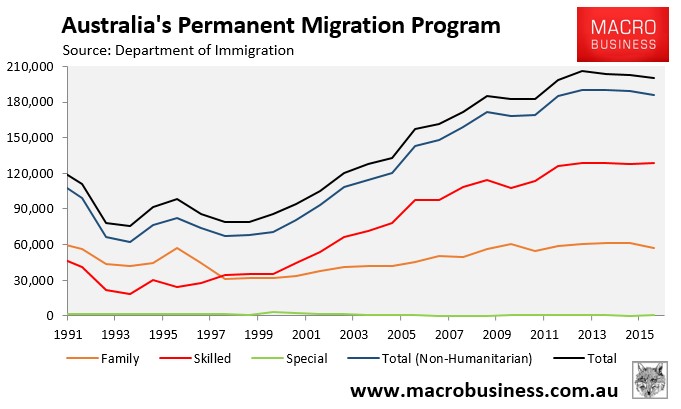Over the weekend, The AFR’s Andrew Clark penned an article arguing, in a roundabout way, that “immigration reform [is] the sleeper issue of the economy and Canberra warfare”:
Immigration, a trigger issue for the Australian psyche, is emerging as a potential sleeper in the next federal election.
According to Australia’s most experienced demographer, Bob Birrell, the current annual intake of about 205,000 should be just about halved to 100-120,000 a year to take pressure off major cities like Sydney and Melbourne.
His remarks accord with positions taken by former Liberal prime minister Tony Abbott and Australian Conservatives leader, Senator Cory Bernardi, and partially parallel an understated recent shift in the Turnbull government’s own policy.
Dr Birrell said there should be a “significant adjustment in size and focus” of the current intake. He is “heartened” the government’s recent series of changes to the immigration program “seemed to indicate a start in that direction”…
Recent moves include “quite tough citizenship changes,” a re-set of the 457 temporary visa program, and a statement on “more performance criteria in visa programs”, said Birrell…
…”those who think that Australia is immune from policy discord on immigration are wrong. The immigration issue is now in play.”
Chris Wright, a senior lecturer in Work and Organisational Studies at Sydney University’s business school, who specialises in the study of labour market behaviour, says Birrell is over-stating the significance of these changes. While the new restrictions “are going to make some people less inclined to come,” more will arrive “under other visas”…
Professor Wright also authored a recent report on migration to Australia which noted the “evident” benefits of a more jobs demand-based program. “Skilled immigrants have offset population ageing, improved labour productivity, helped businesses to source skills that are difficult to find at short notice, and addressed the needs of regional areas and industries,” the Wright report said.
“However, various reforms are needed particularly relating to the treatment of temporary immigrants in order to maintain public support for sustained immigration intakes,” he noted.
My view is that two changes need to be made before it can be claimed that the Coalition is serious about immigration reform.
First, the wages floor for temporary ‘skilled’ workers needs to be lifted dramatically from its pathetically low level of $53,900 (non-indexed), which is 35% below the average full-time salary of $82,789. With the salary floor kept so low, employers will remain incentivised to employ cheap foreign workers over locals.
The fact that the Coalition did not increase the wages floor in its recent 457 visa reform package suggests it is not genuinely serious about curbing visa abuse.
Second, and more importantly, the Coalition in May left Australia’s permanent migrant intake at the ridiculously high level of 200,000 (two-thirds “skilled”), which is 2.5 times the level that existed at the turn of the century and even higher than at the peak of the mining boom:

While temporary ‘skilled’ workers may find it more difficult to gain permanent residency, the overall permanent migrant intake has not changed (just the composition), thus ensuring the population pressures afflicting the nation will remain.
Chris Wright’s purported “benefits” of maintaining a mass immigration program also do not stand up to scrutiny.
First, immigration can only offset population ageing in the short-term and merely pushes the problem further down the road (because migrants age as well), thus requiring ever-larger migrant intakes in the future. The Productivity Commission and others have debunked this ageing population myth repeatedly (see here).
Second, the claim that mass immigration improves labour productivity is highly debatable. Migrants tend to have worse labour market outcomes than the Australian born population (see here).
In any event, only focusing on the ‘benefits’ of “improved labour productivity” because of the purported skills that migrants bring, while ignoring the other deleterious ‘costs’ of mass immigration on productivity is highly disingenuous. As noted by Ross Gittins:
What economists know but try not to think about – and never ever mention in front of the children – is that immigration carries a huge threat to our productivity.
The unthinkable truth is that unless we invest in enough additional housing, business equipment and public infrastructure to accommodate the extra workers and their families, this lack of “capital widening” reduces our physical capital per person and so reduces our productivity…
It’s simple: when you increase the population while leaving our stock of household, business and public capital unchanged, you “dilute” that capital. You have less capital per person, meaning you’ve automatically reduced the productivity of labour.
So you have to do a lot more investing in housing, business structures and equipment and all manner of public infrastructure – a lot more “capital widening” – just to stop labour productivity falling…
It is true that immigration is a sleeper issue for our politicians, given it is an underlying driver behind the perception among the electorate that their living standards are falling, as well as recent political volatility, which has seen numerous leaders lose their jobs and governments from both sides thrown out of office.
The first party that cottons on to this reality, abandons ponzi growth and governs to improve residents’ living standards will rule for a decade.

